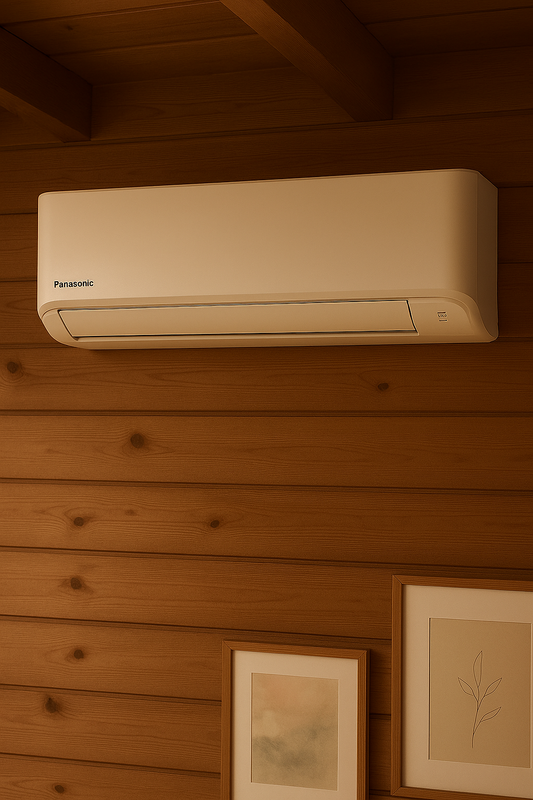Bergvärmepump Installation
En bergvärmepump är en miljövänlig och kostnadseffektiv lösning för uppvärmning och kylning av bostäder och kommersiella fastigheter. Installationen av en bergvärmepump kräver noggrann planering och utförande för att säkerställa optimal prestanda och energieffektivitet.
Definition och Bakgrund
En bergvärmepump utnyttjar den lagrade värmen i marken för att producera värme under vintermånaderna och kyla under sommarmånaderna. Genom att använda en vätska som cirkulerar i en slinga mellan en värmepump och marken, kan bergvärmepumpen dra nytta av markens konstanta temperatur för att värma eller kyla en byggnad.
Bergvärme har använts i decennier som en pålitlig och hållbar energikälla för uppvärmning och kylning. Tekniken har ständigt utvecklats och förfinats för att bli mer effektiv och kostnadseffektiv, vilket har gjort bergvärmepumpar till ett attraktivt alternativ för fastighetsägare.
Fördelar och Användningsområden
Installation av en bergvärmepump erbjuder flera fördelar, inklusive minskade energikostnader, minskad miljöpåverkan och långsiktig hållbarhet. Genom att dra nytta av markens konstanta temperatur kan bergvärmepumpar producera mer energi än de förbrukar, vilket resulterar i betydande besparingar på energiräkningar.
Bergvärmepumpar kan användas i en mängd olika byggnadstyper, inklusive enfamiljshus, flerfamiljshus, kommersiella fastigheter och offentliga byggnader. Denna flexibilitet gör bergvärmepumpar till en attraktiv lösning för en bred målgrupp av fastighetsägare.
Relaterade Tekniker, Begrepp eller Variationer
En vanlig variation av bergvärmepumpen är sjövärme, där värmeutbytet sker med hjälp av vatten istället för mark. Sjövärme kan vara fördelaktigt för fastigheter belägna nära vattendrag eller sjöar, där tillgången till vatten möjliggör effektiv värmeutvinning.
En annan relaterad teknik är luft-vatten värmepumpar, som utnyttjar omgivande luft istället för mark eller vatten för att producera värme. Luft-vatten värmepumpar kan vara ett alternativ i områden där tillgången till mark eller vatten är begränsad.
Vanliga Frågor (FAQ)
-
Är bergvärme lämpligt för alla fastigheter?
Bergvärme kan vara lämpligt för de flesta fastigheter, men en noggrann utvärdering av markförhållanden och fastighetens behov är avgörande. -
Hur lång tid tar installationen av en bergvärmepump?
Tidsramen för installationen varierar beroende på fastighetens storlek och markförhållanden, men installationen kan vanligtvis ta några veckor. -
Vad är underhållskraven för en bergvärmepump?
Bergvärmepumpar kräver regelbunden service och underhåll för att säkerställa optimal prestanda och hållbarhet.
Sammanfattning
Installation av en bergvärmepump är en effektiv och hållbar lösning för uppvärmning och kylning av fastigheter. Genom att dra nytta av markens konstanta temperatur erbjuder bergvärmepumpar betydande energibesparingar och minskad miljöpåverkan. Med noggrann planering och professionell installation kan bergvärmepumpar vara en långsiktig investering för fastighetsägare som strävar efter energieffektiva och hållbara lösningar.
Installation Process
The installation process of a geothermal heat pump involves several key steps to ensure its proper functioning. It begins with a thorough assessment of the property and its geological characteristics to determine the most suitable placement for the ground loop. Once the location is determined, the digging of trenches or the drilling of boreholes is carried out to accommodate the ground loop system. Careful attention to detail during this phase is crucial to maximize the efficiency of heat exchange with the ground.
Energy Performance and Cost Savings
Geothermal heat pumps offer exceptional energy performance and cost savings over their operational lifespan. By harnessing the stable temperature of the earth, these systems can achieve impressive levels of efficiency in both heating and cooling modes. This translates to substantial reductions in energy consumption and related expenses for the property owner. Additionally, many regions offer incentives or rebates for installing geothermal systems, further enhancing their cost-effectiveness.
Case Study: Residential Application
In a residential setting, the installation of a geothermal heat pump resulted in a significant decrease in annual heating and cooling costs. The property owner reported a 30% reduction in energy expenses compared to their previous conventional HVAC system. Moreover, the system's quiet operation and minimal maintenance requirements contributed to a high level of satisfaction and comfort for the occupants.
Environmental Impact and Sustainability
Geothermal heat pumps contribute to a reduced carbon footprint and environmental impact due to their efficient use of renewable energy. By eliminating the need for fossil fuels for heating and cooling, these systems play a crucial role in mitigating greenhouse gas emissions. Furthermore, their long operational lifespan and minimal environmental disturbance during installation make them a sustainable choice for environmentally conscious property owners.
Advancements in Technology
Ongoing advancements in geothermal heat pump technology continue to improve their performance and applicability. Innovations in system design, components, and control algorithms have enhanced their reliability, efficiency, and versatility. Furthermore, integration with smart building management systems and renewable energy sources further expands the potential of geothermal heat pumps in achieving comprehensive energy solutions for modern structures.
System Maintenance and Servicing
Regular maintenance and servicing are essential for ensuring the continued optimal performance of a geothermal heat pump system. This includes periodic inspections, filter replacements, and checks on the fluid levels and pressure within the system. Professional servicing helps identify and address any potential issues before they escalate, thus maximizing the longevity and efficiency of the system.
Geological Considerations for Installation
The geological characteristics of a property play a significant role in determining the feasibility and efficiency of geothermal heat pump installation. Factors such as soil composition, thermal conductivity, and available land area for ground loop installation influence the system's performance. Proper assessment and understanding of these geological considerations are crucial for a successful and effective installation.
Commercial Applications and Benefits
In commercial settings, geothermal heat pumps offer substantial benefits in terms of operational cost savings and environmental stewardship. Large-scale installations can significantly reduce a building's carbon footprint and contribute to sustainable business practices. The long-term financial advantages, coupled with a positive environmental impact, make geothermal heat pumps an attractive choice for commercial property owners.
Performance Monitoring and Optimization
Continuous monitoring of a geothermal heat pump's performance allows for proactive optimization of its operation. Utilizing smart monitoring systems and data analytics enables property owners to fine-tune the system for maximum efficiency. By analyzing performance metrics, adjustments can be made to enhance energy utilization and further reduce operational costs.
Global Adoption and Regulatory Support
Geothermal heat pump technology has gained traction globally, supported by regulatory frameworks promoting renewable energy adoption. Various countries offer incentives, tax credits, and favorable policies to encourage the installation of geothermal heat pump systems. This support underscores the growing recognition of geothermal technology as a key contributor to sustainable energy practices worldwide.
Enhanced Comfort and Air Quality
Besides energy efficiency, geothermal heat pumps contribute to improved indoor comfort and air quality. The consistent temperature control and humidity regulation provided by these systems create a comfortable and healthy indoor environment. Additionally, the absence of combustion processes eliminates indoor air pollutants associated with traditional heating systems, benefiting occupants' well-being.
Installation Considerations
When planning the installation of a geothermal heat pump, factors such as property layout, available space, and local regulations need to be carefully considered. Proper coordination with qualified professionals and adherence to industry standards are essential to ensure a seamless and compliant installation process.
Geothermal Heat Pump Components
A geothermal heat pump system comprises various components, including the heat pump unit, ground loop, and distribution system. Understanding the function and interplay of these components is crucial for optimizing the system's performance and longevity.
Geothermal Heat Pump Sizing
The proper sizing of a geothermal heat pump is critical to its efficiency and effectiveness. Accurate assessment of the property's heating and cooling demands, coupled with load calculations, guides the selection of an appropriately sized system for optimal energy utilization.
Geothermal Heat Pump Efficiency Standards
National and international efficiency standards govern the performance criteria for geothermal heat pump systems. Compliance with these standards ensures that the installed systems meet defined efficiency benchmarks, contributing to energy conservation and environmental sustainability.
Remote Monitoring and Control
Advancements in technology enable remote monitoring and control capabilities for geothermal heat pump systems. Property owners can access real-time performance data and adjust system settings remotely, enhancing convenience and efficiency in system operation.
Geothermal Heat Pump Financing Options
Financial incentives, leasing programs, and financing options are available to support the installation of geothermal heat pump systems. Exploring these avenues can assist property owners in overcoming initial investment barriers and realizing long-term cost savings.
Geothermal Heat Pump Retrofitting
Retrofitting existing properties with geothermal heat pump systems presents opportunities for energy efficiency upgrades. Proper retrofit planning and execution can transform traditional heating and cooling infrastructures into sustainable and eco-friendly solutions.
Geothermal Heat Pump Case Study: Commercial Application
In a commercial setting, the installation of a geothermal heat pump resulted in substantial reductions in operational expenses and a notable decrease in the facility's carbon footprint. The system's reliability and long-term cost benefits positioned it as a pivotal asset for the business's sustainability initiatives.
Geothermal Heat Pump Case Study: Public Sector Implementation
The adoption of geothermal heat pump systems in public sector facilities showcased significant energy savings and environmental stewardship. The seamless integration of these systems into public infrastructure underscored their role in advancing sustainable and responsible governance.
Geothermal Heat Pump Innovations
Ongoing research and development efforts continue to drive innovations in geothermal heat pump technology. Emerging trends in system design, materials, and energy storage methods hold promise for further enhancing the performance and applicability of these systems.



